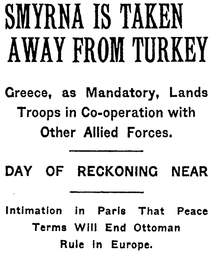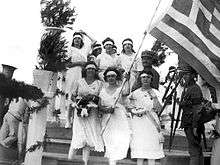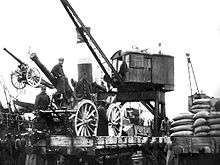Greek landing at Smyrna
| Greek landing at Smyrna | |||||||
|---|---|---|---|---|---|---|---|
| Part of Greco-Turkish War (1919–22) campaign of Turkish War of Independence | |||||||
 Men of the 1/38 Evzone Regiment at the Smyrna quay | |||||||
| |||||||
| Belligerents | |||||||
|
|
| ||||||
| Commanders and leaders | |||||||
| Colonel Nikolaos Zafeiriou¹ |
Ali Nadir Pasha² Hürrem Bey³ Ali Bey⁴ Kâzım Bey⁵ | ||||||
| Strength | |||||||
| up to 15,000 soldiers[5] | 3,000 soldiers[6] | ||||||
| Casualties and losses | |||||||
|
6–20 wounded[7][8] |
30–40 killed (killed in captivity or during surrender)[9][10][11] 40–60 wounded[10][11] | ||||||
| 1: Commander of the Greek 1st Division, 2: Commander of the Ottoman XVII Corps, 3: Commander of the Ottoman 56th Division, 4: Commander of the 172nd Infantry Regiment (Ayvalık), 5: Commander of the 173rd Infantry Regiment (Urla) | |||||||
The Greek landing at Smyrna (modern-day İzmir) was a military operation by Greek forces starting on May 15, 1919 which involved landing troops in the city of Smyrna and surrounding areas. The Allied powers sanctioned and oversaw the planning of the operation and assisted by directing their forces to take over some key locations and moving warships to the Smyrna harbor. During the landing, a shot was fired on the Greek 1/38 Evzone Regiment and significant violence ensued with Greek troops and Greek citizens of Smyrna participating. The event became important for creating the three-year-long Greek Occupation of Smyrna and was a major spark for the Greco-Turkish War (1919–1922).
Prelude
At the end of World War I (1914–1918) and with the Armistice of Mudros that ended the Ottoman front of World War I, the allies began a series of peace talks focused on the Partitioning of the Ottoman Empire. During Paris Peace Conference, 1919 the Italians landed and took over Antalya and began showing signs of moving troops towards Smyrna.[12] When the Italians left the meeting in protest over other issues, British Prime Minister David Lloyd George and Greek Prime Minister Eleftherios Venizelos pushed a concocted report in the peace negotiations alleging that the Christian populations were under direct threat to convince France and the U.S. to support a Greek takeover of the Aidin Vilayet centered in Smyrna.[13] Borders and terms of the Greek occupation were not decided but in early May 1919, the Allied powers supported Greek troops landing in Smyrna and moved a number of battleships into the area to prepare for the landing.
While negotiations were still in progress, Venizelos informed Clemenceau of the deterioration of the situation in Aidin Vilayet, where the local governor, Nureddin Pasha, was ordering Muslim groups to commit excesses against the Greek population. The British intelligence was also informed of the deterioration of law and order in the area and the Italian role in provoking this situation. In early May, Venizelos reported instances of Italian-Turkish cooperation to the Supreme Allied Council and requested that Allied vessels should be sent to Smyrna. This request, although initially accepted by the Council, was not carried out immediately.[14] Under this context, the British Prime Minister and the Foreign Office were the main supporters of the Greek landing, with the purpose "to restore public order and forestall the massacres".[15]
Turkish reactions
The Society for the Defense of Ottoman Rights in Izmir[16][17] (İzmir Müdafaa-i Hukuk-ı Osmaniye Cemiyeti) was organized to prepare for the arrival of Greek troops. Nureddin Pasha was appointed governor of the Aidin Vilayet and Aidin Area Command (Aydın Bölge Komutanlığı), and supported activities of the Society for the Defense of Ottoman Rights in Izmir. But he resigned under pressure of the Allied Powers. "Kambur" Ahmed Izzet Bey was appointed as new governor on March 11, and retired general Ali Nadir Pasha was appointed to the post of military commander on March 22, 1919. [7]
Allied fleet
In the early weeks of May 1919, allied warships entered the area to prepare for the operation. British Admiral Somerset Gough-Calthorpe was the primary commander for the operation involving British, U.S., French, Italian, and Greek forces. On May 11, 1919, Rear Admiral Mark L. Bristol, the Commander of US Naval Detachment in Turkish Waters), came to Izmir from Istanbul on a battleship. The British forces would occupy Karaburun and Uzunada, French forces would occupy Urla and Foça, Greek forces would occupy Yenikale fortress.
The Greek landing



On the afternoon of May 11, 1919, the Commander of the 1st Infantry Division of the Hellenic Army, positioned in Kavala, Colonel Nikolaos Zafeiriou, received orders for the operation. The next morning, the landing force, consisting of 13,000 soldiers, as well as auxiliary personnel, 14 transport ships and escorted by 3 British and 4 Greek destroyers, headed to Smyrna.[18] Zafeiriou's order to his soldiers, who learned about their destination only after the departure, was the following:
Wherever we may go, we must know that we are going to liberate our brethren under alien rule. The enthusiasm filling our hearts is fully justified but any improper manifestation of this enthusiasm will be entirely out of place. We must not forget that when we reach our destination we shall meet Turks, Jews and Europeans of other denominations. Everybody should be treated in the same way. In a little while they will become our brothers as if they were true Greeks.[19]
On May 14, 1919, the Greek mission in Smyrna read a statement announcing that Greek troops would be arriving the next day in the city. Smith reports that this news was "received with great emotion" by the Greek population of the city while thousands of Turkish residents gathered in the hill that night lighting fires and beating drums in protest.[20] Later, translations of proclamations issued by the Turks during this occasion, showed that the intention was not purely pacific resistance.[20] The same night, several hundred prisoners, mostly Turks, were released from a prison, with the complicity of the Ottoman authorities and Italian major in charge of the prison.[20] Some of them armed purchased arms from a depot near the barracks.[20]
The Greek occupation of Smyrna started the following day, where thousands were gathered on the seafront, waving Greek flags on the docks where the Greek troops were expected to arrive. The Metropolitan of Smyrna, Chrysostomos of Smyrna blessed the first troops as they arrived at 08:00.[13] A colonel, who had neither the will nor the prestige to force himself relentlessly on his men, was in charge of the operation and neither the appointed High Commissioner nor high-ranking military individuals were there for the landing resulting in miscommunication and a breakdown of discipline.[21] Most significantly, this resulted in the 1/38 Evzone Regiment landing north of where they were to take up their post. As a result, they had to march south passing a large part of the Greek crowds celebrating the landing and also the Ottoman government Konak and the barracks of Ottoman troops. A Turk fired a shot (Smith indicates that no one knows who fired the shot) and chaos resulted with the Greek troops firing multiple shots into the Konak and the barracks.[13] The Ottoman troops surrendered and the Greek regiment begun marching them up the coast to a ship to serve as a temporary prison. Allied officers in the harbor reported seeing Greek troops bayoneting multiple Turkish prisoners during the march and then saw them thrown into the sea.[13] Prisoners were forced to shout "Long live Venizelos!" and "Long live Greece!".[22] Donald Whittall, a British citizen and one of the few neutral observers during the landing, remarked about the treatment of Turkish prisoners, "They were made to go through no humiliation and received a good deal".[22] But Whittall estimated that thirty unarmed prisoners were slaughtered.[22] No atrocities were committed by the Greek crowd and Greek soldiers, who were able to be restrained from shooting the prisoners by their officers.[22] The captain of the HMS Adventure reported that a Turkish officer, marching with his hands up, veered out of line.[22] He was hit by a Greek soldier's rifle butt on the back of his head. When he tried to stand up he was hit again and bayoneted, before the top of his head was blown off.[22]
Violence and disorder followed the landing and Greek troops and Greek citizens of Smyrna participated in these actions.[13] Some shops belonging to Jews were also plundered by Greek soldiers.[23] For the days following the landing, Greek troops arbitrarily detained around 2,500 people.[7] Looting of Turkish houses in the city and in the surrounding areas began on the night of May 15 and continued for many days after that.[13] The Inter-Allied Commission of Inquiry reported that:
On 15 and 16 May, countless acts of violence and looting targeted at the Turkish people and their homes took place in the town. Fezzes were stolen, which prevented the Turks from leaving their homes. Many women were raped. Some people were murdered. These acts of violence and looting were committed for the most part by a mob of Greeks from the town, although it has been proven that soldiers also joined in and that the military authorities took no effective measures to stop the acts of violence and looting until it was too late.[7]

Admiral Calthorpe left the area on May 21 and on May 23, the Greek commander in the area went against orders issued by the Allies and Venizelos by ordering the expansion of military operations in Aydin and Şuhut.[7] These operations initially did not face significant resistance, but ethnic violence erupted along the way leading to significant violence and chaos; particularly in the Battle of Aydin from May 27 until June 27, 1919. In many areas, Greek forces demobilized the Ottoman police and then left the area resulting in Turkish mobs looting Greek property and killing Greek citizens.[7] This was retaliation for atrocities committed by Greek soldiers and civilians in Smyrna and the surrounding area against Turks.[24]
When the atrocities were exposed and condemned by the British House of Commons on 26 June, Venizelos faced British diplomatic pressure to conduct an official inquiry.[24] Court martial in August 15, 1919 led by the Greek High Commissioner for the violence on May 15 and May 16 pronounced 74 convictions (including 48 Greeks, 13 Turks, 12 Armenians and one Jew).[7]
According to the Inter-Allied Commission of Inquiry, the casualties on 15 May were as follows: Greek army (2 killed, 6 wounded); 100 Greek civilians (20 killed, 20 drowned, 60 wounded); 300-400 Turkish civilians killed or wounded.[7] Eyewitnesses in Smyrna reported higher civilian casualties among the Turks. The U.S. Naval Officer of the USS Arizona, which was berthed at Smyrna harbor, estimated 300-500 Turks killed with a total of 700-1000 casualties.[8] Regarding the Greek casualties, he estimated 2 killed and 15-20 wounded soldiers, 20-30 killed and 40-50 wounded civilians[8] Reverend MacLachlan, a Canadian in charge of the international college at Smyrna, estimated 400-600 Turks killed.[8]
Impacts
The Greek army from the first started showing the signs that they had not come for a temporary occupation but rather for a permanent annexation; to incorporate western Anatolia into Greece. This intention was already clear to some Turks after seeing which territories that Greeks had occupied. The Turkish reaction to these developments was anger, resulting in violence in the region. After the initial shock of the landing, Turkish groups started retaliating by committing excesses against the civilian Greek communities residing outside of the occupation zone.[14] While there were large demonstrations against Allied Forces in Istanbul, in Anatolia first armed clash occurred on 28 May at Ödemiş between a small body of Turks and Greek army. Afterwards, Turkish guerrilla warfare flared up along the line of Greek advance.[25]
The Greek Landing at Smyrna created the Smyrna Zone that administered the area from 1919 until September 9, 1922. After the violence in May 1919, many of the allies began to limit their support for the operation: France and Italy all became resistant to permanent Greek occupation and the dead-born Treaty of Sevres in 1920 gave administrative control of the area to Greece, while Turkey would retain sovereignty, with permanent sovereignty to be decided after 5 years.[12] The Greek occupation ended when Turkish forces entered Smyrna (İzmir) on September 9, 1922.
See also
References
- ↑ Smyrna is taken away from Turkey, New York Times, 17 May 1919.
- ↑ George F. Nafziger, Mark W. Walton: Islam at war: a history, Greenwood Publishing Group, 2003, ISBN 0275981010, page 131.
- ↑ Gerald E. Wheeler, Naval Historical Center (U.S.), Kinkaid of the Seventh Fleet: a biography of Admiral Thomas C. Kinkaid, U.S. Navy, Naval Historical Center, Dept. of the Navy, 1995, ISBN 0945274262, page 25.
- ↑ H. P. Willmott: The Last Century of Sea Power, Volume 1: From Port Arthur to Chanak, 1894–1922, Indiana University Press, 2009, ISBN 0253003563, page 332
- ↑ Eleftheria, Daleziou (2002). "Britain and the Greek-Turkish War and Settlement of 1919-1923: the Pursuit of Security by "Proxy" in Western Asia Minor". University of Glasgow. p. 108. Retrieved 11 July 2014.
- ↑ Solomonidis, Victoria (1984). "Greece in Asia Minor: The Greek Administration in the Vilayet of Aydin" (PDF). University of London, King's College. p. 54. Retrieved 5 June 2014.
the Turkish troops comprising about 3,000 men were to remain confined to their barracks behind the Konak.
- 1 2 3 4 5 6 7 8 Inter-Allied Commission of Inquiry. "Documents of the Inter-Allied Commission of Inquiry into the Greek Occupation of Smyrna and Adjoining Territories" (PDF). Retrieved 10/2/2012. Check date values in:
|access-date=(help) - 1 2 3 4 Stavros T. Stavridis : The Greek-Turkish War, 1918-23: an Australian press perspective, Gorgias Press, 2008, ISBN 1593339674, page 117
- ↑ See: Michael Llewellyn Smith, 1999, page 90.
- 1 2 Tuncer Baykara: Son Yüzyıllarda İzmir ve Batı Anadolu Uluslararası Sempozyumu tebliğleri, Akademi Kitabevi, 1994, page 98 (Turkish)
- 1 2 Enver Behnan Şapolyo: Türkiye Cumhuriyeti tarihi, A. H. Yaşaroğlu, 1960, page 12 (Turkish)
- 1 2 Montgomery, A. E. (1972). "The Making of the Treaty of Sèvres of 10 August 1920". The Historical Journal. 15 (04): 775. doi:10.1017/S0018246X0000354X.
- 1 2 3 4 5 6 See: Michael Llewellyn Smith, 1999, pg. 88-92
- 1 2 Solomonidis, 1984, pg. 43
- ↑ Solomonidis, 1984, pg. 47
- ↑ Erik Jan Zürcher, The Unionist Factor: the Rôle of the Committee of Union and Progress in the Turkish National Movement, 1905–1926, BRILL, 1984, ISBN 90-04-07262-4, p. 92.
- ↑ . L. Macfie, The End of the Ottoman Empire, 1908–1923, Longman, 1998, ISBN 978-0-582-28763-1, p. 186.
- ↑ Solomonidis, 1984, pg. 52
- ↑ Solomonidis, 1984, pg. 52-53
- 1 2 3 4 See: Michael Llewellyn Smith, 1999, pg. 88
- ↑ See: Michael Llewellyn Smith 1999, pg. 91
- 1 2 3 4 5 6 See: Michael Llewellyn Smith, 1999, pg. 89-90
- ↑ Çağrı Erhan: Greek Occupation of Izmir and Adjoining Territories: Report of the Inter-Allied Commission of Inquiry (May–September 1919), Center for Strategic Research (SAM), 1999, page 20.
- 1 2 Mark Alan Lewis: International Legal Movements Against War Crimes, Terrorism, and Genocide, 1919--1948], ProQuest, 2008, ISBN 1109079222, page 115.
- ↑ Lewis, Bernard (1961). The Emergence of Modern Turkey. Oxford University Press. pp. 241–243.
Bibliography
- Celal Erikan, Komutan Atatürk, Cilt I-II, Üçüncü Basım, Türkiye İş Bankası Kültür Yayınları, İstanbul, 2001, ISBN 975-458-288-2. (Turkish)
- Hakkı Güvendik, Türk İstiklâl Harbi, Batı Cephesi, Yunanlıların Batı Anadolu'da İstila Hareketlerine Başlamaları, İzmir’in İşgali, Mustafa Kemal Paşa'nın Samsun’a Çıkması, Millî Mukavemet'in Kurulması (May 15ıs – 4 Eylül 1919), Cilt 2, Kısım. 1, Genkurmay Başkanlığı Basımevi, Ankara, 1963. (Turkish)
- Michael Llewellyn Smith, Ionian Vision : Greece in Asia Minor, 1919-1922., C. Hurst, 1999, London, New edition, 2nd impression.
- Zekeriya Türkmen, Mütareke Döneminde Ordunun Durumu ve Yeniden Yapılanması (1918–1920), Türk Tarih Kurumu Basımevi, 2001, ISBN 975-16-1372-8. (Turkish)
- Solomonidis, Victoria (1984). "Greece in Asia Minor: The Greek Administration in the Vilayet of Aydin" (PDF). University of London, King's College. Retrieved 5 June 2014.
External links
- Greek Occupation of Izmir and Adjoining Territories: Report of the Inter-Allied Commission of Inquiry (May–September 1919), SAM, 1999.
- Greek atrocities in the Vilayet of Smyrna (May to July 1919) Inedited documents and evidence of English and French officers.
